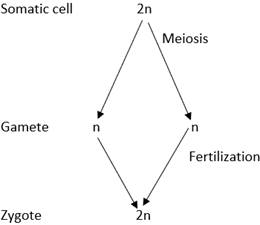Mention the total number of chromosomes along with sex chromosomes that are present in a human female and a human male. Explain how in sexually producing organisms the number of chromosomes in the progeny remains the same as that of the parents.
Male has 22 pairs of allosome and 1 pair of sex chromosome XY that is 44 + 2 = 46 chromosomes.
Female has 22 pairs of allosome and one pair of sex chromosome XX that is 44 + 2 = 46 chromosomes.
A number of chromosome of a particular organism is always constant because of mitosis/equational division and meiosis/reductional division.
This is done as follows gametes are formed by the meiosis during the process of gametogenesis. As a result chromosome gets reduced into half. When these gametes fuse, that is, at the time of fertilization, the number of chromosomes becomes equal to that in a somatic cell. After this, when cells multiply due to mitosis, the number of cells become consistent.

For example: In the case of humans, they contain 2n = 46 chromosomes in somatic cell. Now when meiosis takes place, the number of chromosomes in gametes become n = 23. When fertilisation takes place, the gametes fuse to form a zygote with ploidy n+n = 2n that is, 46 chromosome. Hence, maintaining the constancy in these three stages.